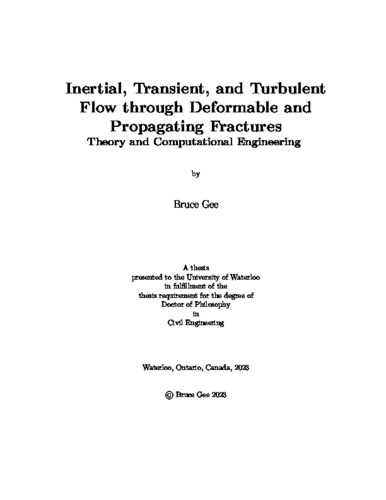| dc.description.abstract | Fluid flow in deformable fractures is important to many natural and industrial geological engineering applications including contaminant transport, geothermal energy, and hydraulic stimulation. Large-scale simulations of flow through fractures are almost exclusively based on the Poiseuille flow model which contains the ingrained assumptions of laminar quasi-steady-state flow conditions with negligible inertia. The high flow rates involved in industrial applications bring these assumptions into question, but the only alternative is the Navier-Stokes equations which are computationally prohibitive at reservoir scales. This thesis seeks to address the gap in available models by introducing a new reduced-dimension model that is capable of capturing inertial and transient flow behaviours without the computational burden of the Navier-Stokes equations.
First, a new fracture flow model is derived from the higher-dimensional Navier-Stokes equations by integrating over the fracture aperture and making simplifying assumptions which are less restrictive than those of Poiseuille flow. This new model, dubbed the GG22 fracture flow model, yields a two-field model (fluid flux and pressure) governed by the conservation of mass and momentum. The GG22 model conserves energy and is shown to include both Poiseuille flow and Forchheimer flow as limiting cases. The performance of the GG22 model is verified against the existing Poiseuille flow model and the solution to the full Navier-Stokes equations in three benchmarks problems. The GG22 model demonstrates complex transient and inertial behaviours not previously captured and produces up to 400% improvements in error over Poiseuille flow in steady-state flow conditions for 1 ≤ Re ≤ 100. The GG22 model is demonstrated to be superior in all tested applications where the inertial forces are greater than viscous forces (Re ≥ 1) and when aperture varies in space and/or time.
Next, a simulator to solve the GG22 governing equations in rigid fractures is developed. Novel numerical methods were developed as the GG22 model is more complex than Poiseuille flow. Since the GG22 model is derived from the Navier-Stokes equations, numerical methods developed for the Navier-Stokes equations may be adapted, but the new model contains its own idiosyncrasies which must be addressed. An explicit multi-step finite volume method is developed and verified. The method is based on deriving a Poisson equation for pressure with an additional continuity correction to overcome numerical instabilities. The critical timestep is derived and shown to be a function of the fundamental frequency of the fracture-fluid system and the maximum fluid velocity. The results show excellent agreement with analytical solutions, and the method demonstrates a first-order rate of fluid flux convergence in time and a second-order rate of pressure convergence in space. Applying the model to a travelling aperture wave simulating seismic excitation reveals the changes in behaviours introduced by inertia and transience. These behaviours include lower average fluxes, higher pressures, and phase-shifts in the fluid response compared to the predictions of Poiseuille flow.
Finally, the GG22 model is numerically coupled with mechanical deformation of a rock mass to simulate the complex industrial applications of interest. A monolithic fully-coupled hydro-mechanical finite element - finite volume model with cohesive fracture propagation is developed and verified. The Newton-Raphson solution algorithm demonstrates poor iterative convergence behaviour, so an adaptive steepest descent line-search with Aitken relaxation is introduced to improve the rate of convergence. The hydro-mechanical model is applied to fracture flow between oscillating elastic plates. The combined effects of inertia and transience are demonstrated to create phase-shifts in the fluid response, larger fluid pressures and rock mass stresses compared to the Poiseuille flow predictions, and induce wave-like behaviour even in a quasi-static rock mass.
The hydro-mechanically coupled fracture propagation model is used to examine the role of inertia and turbulence in the propagation of planar KGD-like and axisymmetric radial hydraulic fractures with constant fluid injection rates. In KGD-like fracture, inertial effects are negligible at flow rates that could be expected in practice. If the injection rate is large enough to invoke turbulence, then significantly different fracture propagation behaviour is observed. Turbulence in KGD-like fractures leads to shorter fractures with larger apertures due to the increased fluid resistance. In radial fractures, the effects of inertia and turbulence only manifest near the wellbore and lead to changes in fracture shape, but have little impact on tip behaviour or fracture length. Turbulence creates increased wellbore pressures and apertures while inertial effects decrease the wellbore pressure and aperture. Turbulent and inertial effects near the wellbore account for the majority of the pressure loss along the fracture and provide a potential explanation for the empirically observed phenomenon of entrance losses. Turbulent and inertial forces have significant effects on injection pressure predictions, and predictions which neglect these phenomena are likely to exhibit significant deviations from the true pressure behaviour. Using water as the injection fluid, turbulence is the dominant mechanism that leads to departures from the Poiseuille flow solution at high Re. The solution departs immediately upon the manifestation of turbulence, while inertial effects manifest at higher flow rates. Using slickwater as the injection fluid, the opposite trend is observed: inertial effects manifest first at modest flow rates, while turbulent effects are delayed to higher flow rates.
In general, high Reynolds number flow is more common in industrial fracture flow applications than considered by current models. The threshold for departure from the Poiseuille flow solution is low and the differences in the solutions are large. This thesis provides a new model to bridge the gap between the physically restrictive Poiseuille flow model and the computationally prohibitive Navier-Stokes equations for the simulation of coupled flow processes in fractures. This new model provides a resource for the analysis and viability of many different applications including geothermal energy, carbon storage, seismic analysis, and contaminant transport among many others. It is recommended that the GG22 model be adopted for the modelling of fracture flow applications in all cases. | en |

